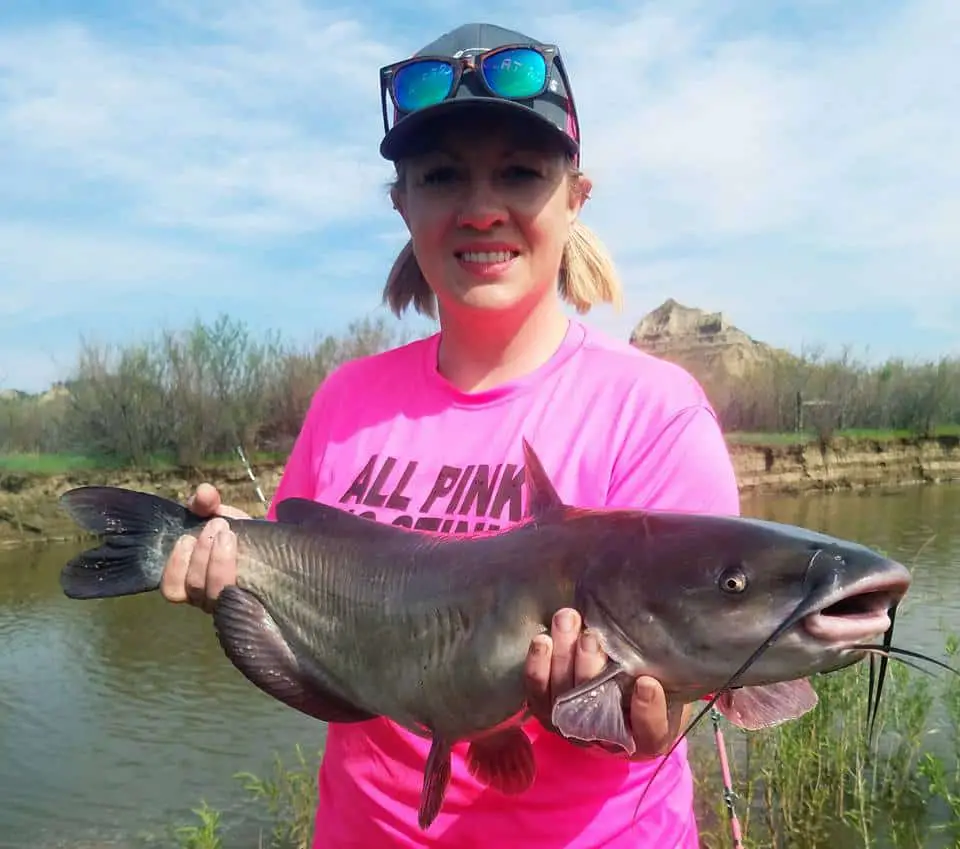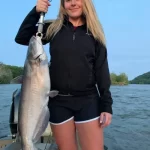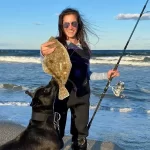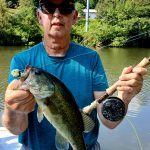13 Useful Channel Catfish Fishing Tips!
This post will list 13 useful channel catfish fishing tips. Fishing for catfish is gaining in popularity all over North America. Of the three major catfish species, channel catfish are the most widely distributed and are available to most anglers. Channel catfish are found in many environments and have a quite varied diet.
Channel catfish, Ictalurus punctatus, is the most numerous of the catfish species. They inhabit streams, rivers, ponds, ad larger lakes. The world record channel catfish is 58 pounds, though they average around 5 pounds.

Special thanks to Ann White, a dedicated catfish tournament angler, for the pics and tips. Ann and Eddie White run Fish Hard, which offers great gear to anglers. Eddie also runs fishing charters on the East Yellowstone River in Montana.
13 useful channel catfish fishing tips
The following 13 useful channel catfish fishing tips will help anglers experience more success. These tips will not only focus on catching channel catfish, but also the differences between them and other catfish species.
1) A medium spinning rod and reel is best for fishing for channel catfish from shore

While there is no one best rod and reel combination for all channel catfish situations, a medium to medium heavy spinning rod and reel is the best all round choice when fishing from shore. The main advantage in a spinning outfit over a conventional, or baitcasting outfit, is the ability to cast. Experienced anglers can cast a long way with conventional tackle, but most anglers will do better with spinning tackle.
Read this article on the best catfish fishing tackle

A lot of anglers pursue channel catfish from shore. This can be done on the bank of a river or lake as well as docks, bridges, and piers. The ability to make long casts gives spinning tackle the nod. A 7′ to 8′ medium action rod with a 5000 series reel spooled up with 20 pound monofilament or braided line will get the jog done.
2) Conventional tackle works very well for channel catfish fishing

It would be hard to argue against a medium conventional, or baitcasting, outfit as being the beast all round outfit when channel catfish fishing. This is especially true for anglers fishing from boats. These rods can be cast a short distance. Conventional reels provide anglers with much more power that a spinning reel can. A 7′ medium heavy rod with matching reel works well.
3) Channel catfish love rivers

Channel catfish love rivers! In fact, it is safe to say that more channel catfish are caught in medium sized rivers with moderate to slow current than in all other waters combined. Channel cats will use submerged cover such as trees to break the current, ambushing prey as it goes by.
Read more about fishing for river catfish
The top spots by far for river channel catfish are outside bends. Current will gouge out a deep hole in these bends. Debris such as tree limbs and other cover will collect in these spots as well. They result in the perfect places for channel catfish to thrive.
4) Nightcrawlers are a top channel catfish bait

Nightcrawlers are an outstanding bait for channel catfish. In fact, they will catch just about every other freshwater species as well. Nightcrawlers are readily available at many retail stores and are easy to keep alive. Some serious catfish anglers may consider other species a nuisance, but most are happy to catch other fish as well. The nightcrawler is usually hooked through the middle several times. Some anglers use several at once.
5) Cut bait produces all catfish species

Cut bait is extremely productive on channel catfish as well as blue catfish and flathead catfish. In fact, anglers fishing in waters where these species are an option will find cut bait to be an excellent choice. Fresh caught bait is best, including shad, herring, and suckers. Anglers need to check local regulations. The bait is usually cut into chunks, or steaks, as opposed to strips.
6) Circle hooks are used by most anglers channel catfish fishing

Circle hooks are used by most anglers chasing channel catfish. They have several advantages over “J” hooks. Circle hooks will usually hook the catfish all by itself, the angler just needs to come tight and lift the rod tip. They are also very strong, which is important when pulling a big fish away from heavy cover. Finally, circle hooks reduce mortality, most fish are hooked in the corner of the mouth. 8/0 is a good all-round size.
7) Bottom rigs produce the most channel catfish

As most anglers realize, most catfish species feed right on or near the bottom most of the time. They will feed higher in the water column, but presenting baits on the bottom is the most effective technique. Special flat “no roll” or “coin” sinkers work very well in river current. Leaders are usually kept fairly short. A float is sometimes added to add color and raise the bait up a tad.

A 3 way rig is another excellent channel catfish fishing rig. Anglers use this often in areas with a lot of snags. It keeps the bait up off the bottom. Also, by using a lighter dropper to the sinker, if the sinker fouls and breaks off, the rest of the rig is saved.
8) Channel catfish fishing is productive in the dark

Most catfish are nocturnal feeders, and channel catfish are no exception. They have an incredibly keen sense of smell to locate food. Catfish can feed in absolute darkness, often having an advantage over their prey. As the picture shows, they can even be caught on artificial lures.
9) Channel catfish are not “scavengers”

Catfish often get a bad reputation for being bottom feeding scavengers. This is not the case! Channel catfish are active predators that prefer a live, frisky bait over a rotting chunk of flesh. In fact, quite a few channel catfish are caught on artificial lures meant for other species. Live worms, bait fish, crayfish, and insects will produce channel catfish.
10) Prepared baits are convenient and effective for channel catfish

Anglers have another option when it comes to channel catfish fishing bait; commercially prepared baits. The main advantage of these baits in the convenience. Back in the day, anglers referred to them as “stink baits”. This is no longer the case. They come in a variety of types, adding color and scent. They keep for a long time in a tackle box with no special handling or mess.
11) Channel catfish require careful handling

Channel catfish, like all catfish, can inflict damage to careless anglers. They have barbed fins on the top and side. These fins have toxin as well. Any angler getting stuck will experience pain and perhaps infection. There are plenty of quality tools that can be used to safely handle catfish, whether keeping them to eat or for those to be released.
12) Tailwaters are terrific spots for channel catfish

There is no such thing as a guaranteed fishing spot, shot of a hatchery or stocked private pond. However, tailwaters are as close as it comes to being that. A tailwater is the section of a river, just below a dam. This is a natural feeding spot as there is a lot of current. Some of the best trout fisheries are in tailwaters.
The turbines often chop up helpless shad and herring, along with other smaller fish. This results in a stream of food coming through the dam. Many times, anglers are allowed to fish from shore near the dam. Anglers in boats need to be careful of the strong currents. There are usually a lot of rocks and other cover which holds fish of all species.
13) Channel catfish are terrific to eat

Finally, channel catfish are fantastic to eat! They are the perfect size, averaging 2 to 5 pounds. Larger specimens are best released to sustain the population. Channel catfish fillets are firm and moist and are very versatile. Many anglers prefer to fry them; hard to argue with that! A little seasoned corn meal and flour is all that is required. They are also good grilled, baked, broiled, and blackened. Anglers need to be responsible and only keep a fish or two for a meal.
In conclusion, this article on 13 useful channel catfish fishing tips will help anglers catch more of these terrific and tasty game fish!






